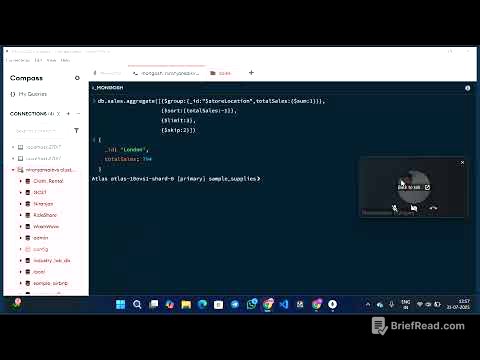TLDR;
This lecture introduces BIO 150, focusing on the intertwining of physiology and behavior, emotions, thoughts, and memories. It emphasizes the importance of resisting categorical thinking to avoid oversimplifying complex human behaviors. The course will cover various biological "buckets" like genetics, endocrinology, and neurology, ultimately aiming to integrate these perspectives to understand behaviors such as sexual behavior, aggression, and mental disorders. The goal is to equip students with a comprehensive understanding of behavioral biology relevant to everyday life, from jury duty to understanding mental health.
- The course explores the interplay between physiology and behavior, resisting the urge to simplify explanations into single categories.
- It aims to understand human behavior by considering genetics, neurology, hormones, and environmental influences.
- The course is structured into two parts: an introduction to biological "buckets" and an analysis of specific behaviors, integrating different perspectives.
Introduction and Course Overview [0:00]
The lecture begins with a scenario of a 40-year-old man exhibiting sudden, bizarre behavior, suggesting that a single gene mutation can drastically alter behavior, setting the stage for exploring the biological influences on behavior. The instructor polls the class on beliefs regarding genetic influences on various aspects like sexual orientation, political opinions, and religiosity, highlighting the diverse perspectives in the room. The course aims to explore the interconnections between physiology and behavior, emphasizing that what happens in the body can influence the brain and vice versa.
The Interplay Between Body and Brain [3:17]
The lecture introduces the central theme of the course: the intricate relationship between physiology and behavior. It uses examples like menstruation, brain tumors, junk food, and anabolic steroids to illustrate how bodily processes can significantly influence behavior, even to the point of being used in legal defenses for murderers. The lecture underscores two key points: first, bodily functions profoundly impact brain activity, and second, mental states can affect the entire body. The course aims to explore these interconnections, especially in the context of complex human social behavior, while avoiding oversimplified categorical thinking.
The Problem with Categorical Thinking [8:07]
The lecture addresses the challenge of understanding the biology of human social behavior, which is inherently complex. It introduces the concept of categorical thinking, where continuous variables are divided into categories to simplify understanding. Examples include categorizing line lengths, running speeds (the four-minute mile), and colors. While useful for storing information, categorical thinking has drawbacks: it can cause us to underestimate differences within a category, overestimate differences across boundaries, and miss the big picture.
Dangers of Categorical Thinking [12:44]
The lecture continues to discuss the problems with categorical thinking, illustrating how language differences can affect perception, such as Finnish speakers not differentiating between "B" and "P" sounds. It also highlights how artificial boundaries, like passing grades, can distort our perception of similarity. An exercise involving phone numbers demonstrates how breaking a familiar pattern disrupts our ability to process information. The lecture uses the example of a number series representing New York City subway stops to show how pre-existing categories can limit our thinking.
Course Goals: Resisting Categorical Thinking [20:22]
The lecture outlines the course's primary goal: to explore the biology of behavior without falling into categorical thinking. Using the example of a chicken crossing the road, the instructor illustrates how different disciplines (endocrinology, anatomy, evolutionary biology) offer distinct explanations, each representing a "bucket" of knowledge. The course aims to resist the temptation to overemphasize any single bucket, instead examining how bodily processes influence behavior and vice versa in a continuous loop. The approach involves analyzing behaviors by tracing back from immediate neural events to sensory stimuli, hormone levels, development, genetics, and evolutionary pressures.
Course Structure and Avoiding Oversimplification [22:27]
The lecture details the structure of the course, which involves examining behaviors by tracing back from immediate neural events to sensory stimuli, hormone levels, development, genetics, and evolutionary pressures. The goal is to avoid oversimplification and recognize that any single explanation (gene, neurotransmitter, trauma) is merely a convenient way of describing the culmination of prior influences. The instructor cautions against the dangers of categorical thinking by presenting quotes from influential scientists who pathologically adhered to single perspectives, such as behaviorism, synaptic adjustment (lobotomies), and racial hygiene.
Intellectual Challenges and Human Uniqueness [33:06]
The lecture outlines three intellectual challenges in studying the biology of human social behavior. The first is recognizing when humans are not unique and behave like other animals, such as the Wellesley Effect of menstrual synchrony. The second is acknowledging when humans use typical physiology in unique ways, such as experiencing stress from abstract concepts like mortality or economic inadequacy. The third challenge is understanding behaviors unique to humans, like non-reproductive sex with post-coital discussion.
Course Structure and Logistics [41:05]
The lecture details the course structure, dividing it into two halves: the first half introduces various biological "buckets" (evolution, genetics, ethology, neurology, endocrinology), while the second half analyzes specific behaviors by integrating these perspectives. The first half is designed to be accessible to students without a science background, with "catchup" sections offered to cover the basics. The course requirements include weekly sections, a midterm, and a final exam, with no prerequisites.
Course Materials and Expectations [46:24]
The lecture discusses course materials, including the textbook "Chaos" by James Gleick, which introduces a non-reductionist way of thinking about biology. The instructor aims to provide online access to readings to avoid requiring a reader. The course website will offer handouts, lecture notes, and announcements. Lectures will be taped and made available online. The midterm will focus on understanding the basics of each discipline, while the final will emphasize thinking across disciplines.

![If I Wanted To Become a Millionaire in 2025, This Is What I'd Do [FULL BLUEPRINT]](https://wm-img.halpindev.com/p-briefread_c-10_b-10/urlb/aHR0cDovL2ltZy55b3V0dWJlLmNvbS92aS9BTjJLcFJCc21SWS9ocWRlZmF1bHQuanBn.jpg)







